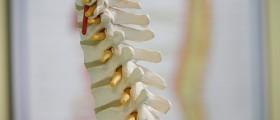
Introduction to ruptured disc in the neck
Spine is basically a pile of the cylindrical bones known as vertebrae. These are stacked on top of one another and fixated by ligaments. This provides the spine with elasticity that cannot be matched by that of any other part of the skeletal system ad that is crucial for movement of the body. Vertebrae are fixed by ligaments, but are separated by "pillows" of soft tissue that are called discs. Discs can rupture or develop a hernia, due to injury or the normal aging process.
Each spinal disc is similar to a soft candy with liquid jelly inside. There is the tough but elastic outer layer and the gel inside. If the outer layer tears, the gel will sip through the tear because of the pressure exerted on the disc. Let's find out why this causes problems.
As all bones, the vertebrae are connected by joints. But, joints between most bones allow only for rotation in one pane of movement. Type of joint between the vertebrae allows the spine to flex, extend and even rotate, all that while carrying significant weight of the body and withstanding tremendous dynamic forces if the body is in motion.
But if any flex, extension or rotation is extreme, the outer layer of the disc might tear. This is very common with discs in the neck region.
The disc undone
If a disc has ruptured, initially, any load on it (such as in everyday activities) will cause leakage of gel from its core. At first there is only some pain in the neck, but once enough gel has been squeezed out, it might press a nearby nerve root and cause pain in neck and shoulders which flows down the arm. Numbness, tingling and arm weakness are also common symptoms as is loss of sensation in the area of the rupture.
Diagnosis
As described symptoms are not unique for this condition, diagnosis will depend on spine tests, such as movement and reflexes tests, X-ray, CT scanning and other tests.
Surgery
Surgery is required only in about five percent of people with a disc rupture, as surgery for this condition does the same as does the natural process of healing, and surgery is considered only if there is no improvement after several months (usually before six months, as then the possibility of permanent nerve damage increases), or if the leakage of gel is causing such pressure on the nerves that might endanger the life of the patient or debilitate him.
There are several surgical procedures. Laminectomy, which removes the lamina on the vertebrae around the disc. Thickened tissue present in the spinal canal is removed as well. Discectomy removes the ruptured disc and serves as an successful alternative when conservative ruptured disc treatment fails. Laminotomy uses arthroscopic approach and is minimally invasive procedure used to open the spinal canal. It relieves the pressure on the exiting nerve roots and spinal cord in the region of ruptured disc.


-Causes,-Symptoms,-Diagnosis,-Treatment_f_280x120.jpg)














Your thoughts on this
Loading...